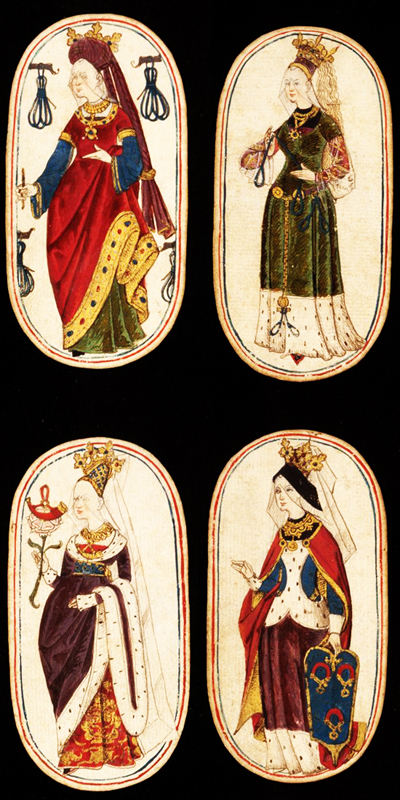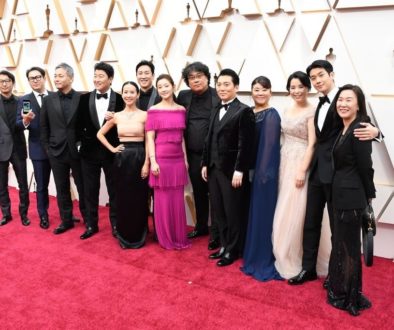Counting Cards
I went to the Cloisters yesterday for a little unicorn research (best kind of research). Though they are not big on anyone taking pictures and therefore I only have one of a flower waving merrily from atop a sign reading POISON PLANT, I ran across a couple of very interesting costumes.
Their Search for the Unicorn exhibit featured this Florentine panel in tempera, which was truly stunning in person, and dates between 1450-60, possibly the zenith of headgear that looked like prototypes of alien spacecraft.
The literal parade of (largely contemporary) costumes is minutely rendered, and it’s well worth zooming in the fullscreen view; the detailing is so intricate you can even see chemises peeking out of the necklines of some of the women. Note the proliferation of undergowns seen in the wide-v dresses; note the length of the hanging sleeves, and that enormous houppelande up front – whatever it looks like she’s holding that got Ye Olde Photoshopped out might be an accident, but a dress that fabulous is always on purpose.
I also got a see a new round of their rotating exhibit of a set of 15th-century playing cards, with the amazing queen in the top right one of the ones on display.
 These are from the southern Netherlands (between 1470-1480ish), so there are some regional differences in the gowns, and while I’m not certain of how trends unfolded in the Netherlands vs. England, I’d venture to say there’s also some difference in terms of era; the tight-sleeve fur-trim gown and the sideless surcote on the bottom being just slightly older than the gowns on top (though still pretty bang-on for, say, the period in England after the War of the Roses, for example, as I laugh/cry about The White Queen all over again); the queen on the top left is contemporary for the time, with an undergown in green, overgown in red, and laced-in outer sleeves in blue. But the green queen I saw actually seems to hew closer to the pre-Tudor transitional style of the late 15th and early 16th centuries.
These are from the southern Netherlands (between 1470-1480ish), so there are some regional differences in the gowns, and while I’m not certain of how trends unfolded in the Netherlands vs. England, I’d venture to say there’s also some difference in terms of era; the tight-sleeve fur-trim gown and the sideless surcote on the bottom being just slightly older than the gowns on top (though still pretty bang-on for, say, the period in England after the War of the Roses, for example, as I laugh/cry about The White Queen all over again); the queen on the top left is contemporary for the time, with an undergown in green, overgown in red, and laced-in outer sleeves in blue. But the green queen I saw actually seems to hew closer to the pre-Tudor transitional style of the late 15th and early 16th centuries.
I’m sure it’s contemporary to the deck – the color scheme, sleeves, and slightly lowered waist all call to mind Hugo van der Goes’ Calvary triptych from 1468, worn by an attendant to Mary – but there are a lot of fanciful touches to this dress that seem to draw it slightly forward in time. This queen (Queen of Hound Tethers, as it turns out) has accessorized sharply with her black partelet (or possible high-neck under-undergown) and the unusual sheer sleeves affixed to the outer gown. These are the elements that stand out, and read as prescient rather than contemporary.
In fact, transition gowns of this age tend to read slightly fantastical to me, and perhaps transitional eras in fashion seem more fanciful in general, since liminal eras often saw more individual and inventive approaches to fashion. The transitional period between early-bustle and late-bustle was the brief but fascinating heyday of the “natural form” dress, which was tight across the hips and slim to the ground, a trend that would appear and vanish all in about five years (among the wealthy; it proved too practical for the working-class to give up). Transitional styles usually turned fringe or vanished entirely after someone in power set a trend that got its claws in for a while and becomes the signature silhouette of the era, as happened in England with the Tudors and Elizabethans; Sue Perkins wryly noted it in the Supersizers episode as she described the white-lead beauty routine that swept the nation under the influence of Liz the First – Elizabeth also started a craze for her favorite colors, white and black, which perhaps not coincidentally were very difficult to obtain and even harder to keep clean and crisp). Ironically, the natural form gown would come back with a vengeance after social and fashion icon Queen Alexandra adopted the narrower silhouette; by the time she became Queen in 1901, it had narrowed right down to the Gibson Girl.
The Queen of Tethers is 400 years away from that, of course, but the onward march of fashion is still visible in the lines of a gown more modern than those of her fellows, but still doomed to disappear under the influence of the Tudors. (Along with that hat, which honestly, might not be such a bad thing, hat-wise. That hat is fanciful in a Star Trek: Next Generation way, and that’s probably not a great sign.)



